While a content management system (CMS) can claim “headless capabilities” by providing an API, simply having an API does not make a headless CMS. Yet that doesn’t stop a lot of vendors from trying to convince you otherwise!
To save you from getting duped, we’ve put together this guide to help marketing professionals understand the ins and outs of APIs. It includes how APIs define the functionality of a headless CMS, the danger of investing in the wrong CMS, and — best of all — the ultimate list for spotting and shutting down a headless CMS imposter before it’s too late.
What Is an API?
An application programming interface (API) is a technology that enables one application to make requests from or invoke actions in another application. In other words, APIs allow computer programs to interface — or communicate — with one another.
Software that uses APIs to provide data and functionality is more flexible, scalable, and integrable, which means it can be valuable and useful to businesses in a variety of ways.
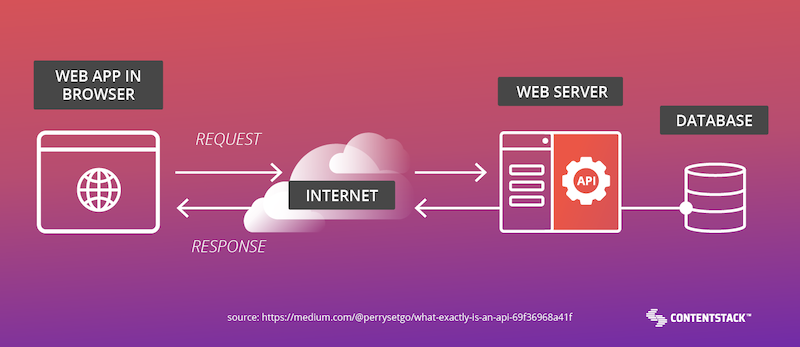
Why Is API Integration Critical to Headless CMS?
Headless CMSes separates content creation and management in the backend (the “body”) from the frontend where the content is formatted and distributed (the “head”).
Using an API makes it possible to deliver content stored in the backend repository to any device or channel — which is central to what makes headless architecture ideal for brands that need to deliver experiences across consumer touchpoints. Which should be all of them, considering that in 2020 the customer experience is expected to “ …overtake price and product as the key brand differentiator.”
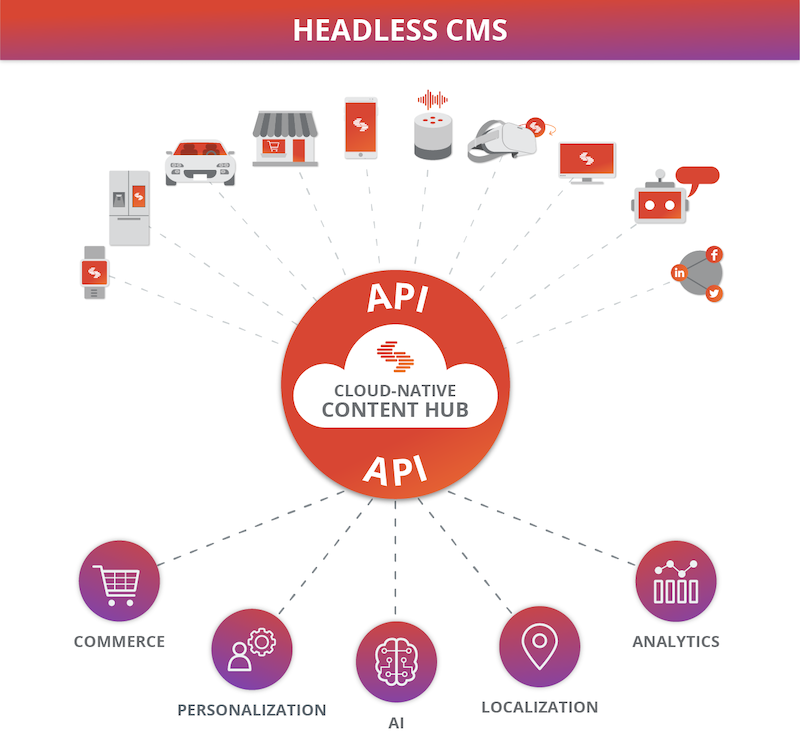
To learn more about the differences between the myriad of content management systems, download our free ebook: The Ultimate Guide to CMS, Vol. 1.
The Challenges of Using a Traditional CMS In Place Of a Headless CMS
On the other hand, there is the traditional, monolithic CMS platform (you may have heard of a few like WordPress and Drupal) that includes a frontend presentation layer (again the “head”) that intertwines with the backend. Because of this entanglement, content must be developed, designed, and delivered in the specific format that the CMS was built to handle. Often, the default delivery channel is either a static website or web-based application.
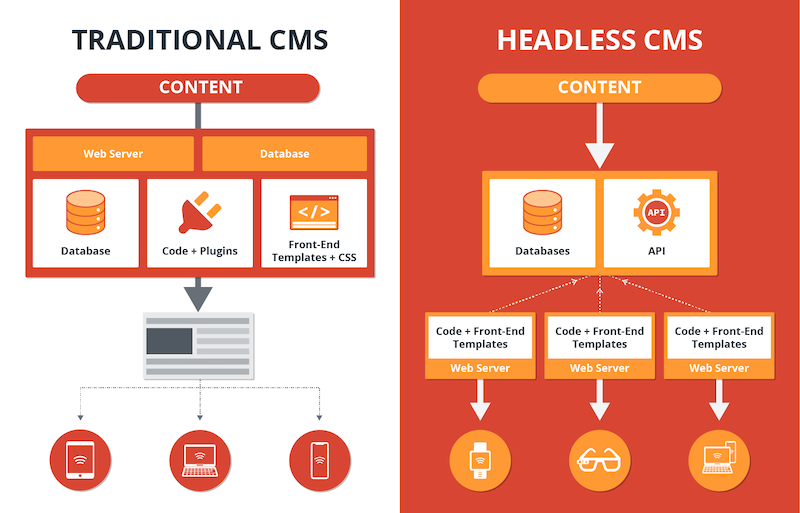
This tight “coupling” of content and presentation is outdated, as it limits how and where organizations can distribute content. To get around this fact, we’ve seen businesses tack modern interface-building (think React) software to a traditional CMS backend to create a DIY “headless” solution.
This approach does have a few advantages, such as:
- Delaying spending time and money to migrate content from one CMS platform to another
- Content managers get to stay in their comfort zone instead of learning the ins and outs of a headless CMS, which may be easier in the short run but can be costly when it comes to advancing their skills keep up with the future of the industry
However, trying to use a souped-up traditional CMS in place of a headless CMS also has plenty of disadvantages.
Speed, Stability, and Security Concerns Associated with Plugins
Traditional CMS platforms almost always come with plugins. Kind of like the poor man’s API, a plugin is a software add-on that extends functionality.
While it’s true that a traditional CMS wouldn’t be nearly as useful without some of these plugins, it’s also true that most traditional CMSes come with more plugins than any business could ever want or need.
Like pulling a cart of rocks uphill, the weight of these plugins slows the website’s performance. When the average load time of Google’s top sites is under three seconds, and 57% of people bounce if a page takes longer than that to load, slow performance is not an option.
Upgrades to plugins can also cause problems. Not all plug-ins are automatically updated to work with the latest release, so using new and old plugins that don’t work together can result in downtime or a broken site.
And, like any third-party integration, plugins introduce security and compliance concerns. In WordPress, for example, plugins are the largest source of security vulnerabilities. And of the ten most vulnerable plugins on WordPress, half are from commercial companies — and one is even a security-focused plugin!
A Poor Editorial Workflow
Even if you tack on multi-channel distribution tools that mimic the flexibility of a headless CMS, the editing workflow in a traditional CMS will always revolve around templates.
That means content managers must follow the technology’s built-in logic when it comes to structuring content — no matter how your business or your content itself needs to evolve with the times.
Costly Maintenance
While you may feel like you’re buying a little slice of security when you invest in a traditional CMS that’s hosted in-house or on an external server, what you’re signing up for is a lifetime of hosting expenses, upkeep, upgrades, security, and version maintenance.
With a cloud-based headless CMS, the software is hosted and managed by the vendor. That means there are no upgrades for you to manage, no hosting bills, no server surprises, and no back-breaking expenses if you suddenly need to scale.
Lack of Flexibility
As we touched on earlier, a traditional CMS is quite opinionated.
Once upon a time, the interdependency between the authoring experience, content visualization, and the vendor ecosystem was a delight for single-channel publishers. But today, you don’t want to be locked into a single selection of plug-ins or a software suite. A headless CMS allows you to pick and choose your technology stack to integrate your preferred AI, CRM, CDP, localization, translation, and other tools to optimize content and publish it across multiple channels, devices, and audiences.
Is your CMS causing astronomical opportunity cost? Find out if your business displays any of the signs now.
How to Spot a Headless CMS “Imposter”
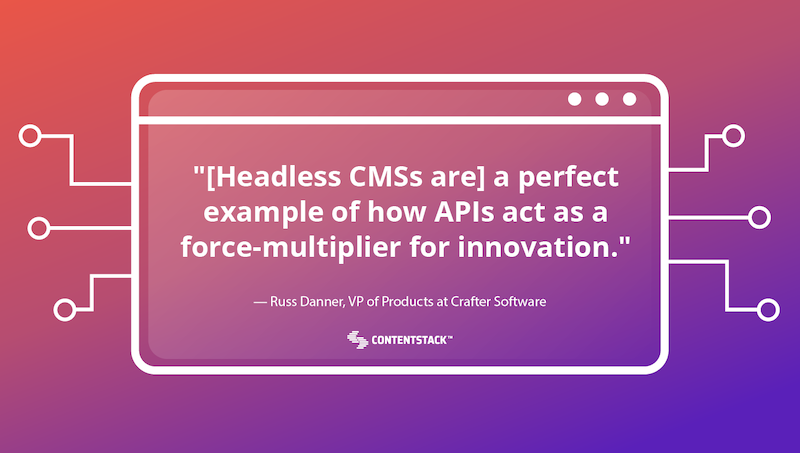
With the growing popularity of headless CMS, it seems like just about every content management provider is looking for a workaround that will allow them to call their platform “headless.”
While imitation is the sincerest form of flattery, we want to make sure you don’t fall for any false advertising. If you’re shopping for a pure headless CMS, this six-step checklist will help you identify and avoid imposters.
1. A headless CMS will offer more than a singular, content-focused API.
Most modern content management systems, both headless and traditional, include some API that pulls content out of a repository.
But as you now know, a single API does not make a headless CMS! If you want a genuinely headless solution, look for details on APIs that enable functionality across the platform — from content creation to management to delivery.
2. A true headless CMS can support any frontend.
Because APIs are used to link the front and backends, a headless CMS solution should be able to work with any frontend. Since it should work with any frontend, any CMS solution you’re looking at should have software development kits (SDKs) that cater to all frontend frameworks, Frontend-as-a-Service providers, mobile apps, and traditional application programming languages.
3. Headless is always API-first.
“Headless” is synonymous with “API-first” because headless architecture is predicated on the assumption that the APIs were there first.
If the CMS you’re looking at is built on pages and templates with APIs layered over the top, you’re probably going to find that that “API-first” architecture starts to crumble the deeper you dig.
4. Headless CMS is (usually) delivered as a service.
Some traditional CMS vendors will sell you usage-based packages, similar to offerings with Software-as-a-Service (SaaS) platforms. But, be careful, as there’s a chance they’re just fancied-up managed services. If that’s the case, you’ll eventually find yourself lacking the flexibility and rapid development pace a service-based headless CMS would offer.
To uncover an imposter, ask how much money and time you can expect to spend on version upgrades. With a true SaaS headless CMS, the answer should be none.
5. Headless CMS is automatically omnichannel.
Technically speaking, any CMS can publish to multiple channels. But with a traditional CMS, you’ll have to create separate content for each channel manually.
A headless CMS serves as many channels and platforms and audiences as you want from a single content source. All the business user has to do is establish rules and implement integrations to translate, localize, and further optimize it.
This distinction is critical, as manually creating content with a traditional CMS can drastically ramp up your overhead costs and kill your speed to market.
6. Headless CMS can flex to fit your use cases—and isn’t afraid to prove it.
You’re about to drop a large sum of money on the platform upon which your entire digital experience will rest. So by all means, take it for a spin!
Headless or not, you want to make sure the CMS you choose is going to fit your business needs.
Even if it’s going to take a small investment, get a test account set up and work through several realistic proofs of concept. If the vendor isn’t willing to let you try before you buy — they likely have something to hide.
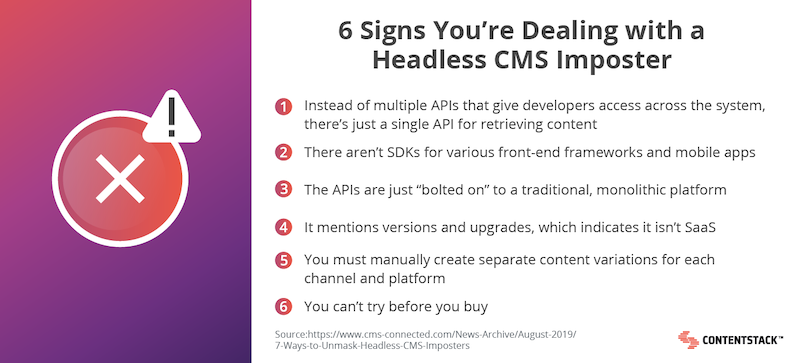
Now that you’re empowered to shut down CMS imposters in their tracks with your API knowledge, why not keep learning?
To learn more about what content architecture can do for your business, check out our guide on How Smarter Content Architecture Drives Business Transformation. And to prepare yourself to dive into CMS shopping, our primer on How to Choose a CMS should give you a great place to start.
If you have questions or want to see a pure headless CMS in action? Get in touch to set up a free, no-obligation proof of concept today.
